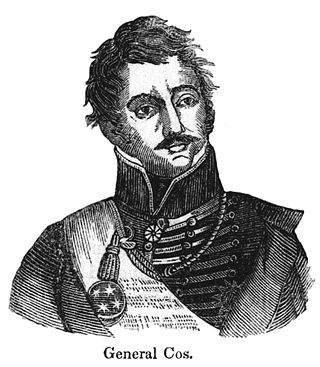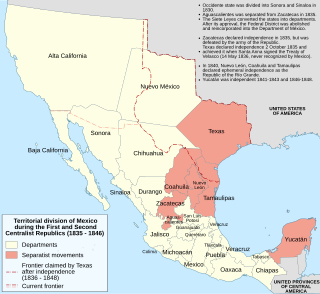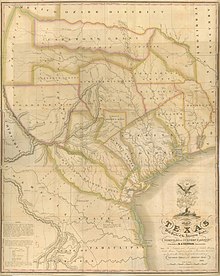
The Texas Revolution was a rebellion of colonists from the United States and Tejanos against the centralist government of Mexico in the Mexican state of Coahuila y Tejas. Although the uprising was part of a larger one, the Mexican Federalist War, that included other provinces opposed to the regime of President Antonio López de Santa Anna, the Mexican government believed the United States had instigated the Texas insurrection with the goal of annexation. The Mexican Congress passed the Tornel Decree, declaring that any foreigners fighting against Mexican troops "will be deemed pirates and dealt with as such, being citizens of no nation presently at war with the Republic and fighting under no recognized flag". Only the province of Texas succeeded in breaking with Mexico, establishing the Republic of Texas. It was eventually annexed by the United States.

Martín Perfecto de Cos was a Mexican Army general and politician during the mid-19th century. Born in Veracruz, the son of an attorney, he became an army cadet at the age of 20, a Lieutenant in 1821, and a Brigadier General in 1833.

The Battle of San Jacinto, fought on April 21, 1836, in present-day La Porte and Deer Park, Texas, was the final and decisive battle of the Texas Revolution. Led by General Samuel Houston, the Texan Army engaged and defeated General Antonio López de Santa Anna's Mexican army in a fight that lasted just 18 minutes. A detailed, first-hand account of the battle was written by General Houston from the headquarters of the Texan Army in San Jacinto on April 25, 1836. Numerous secondary analyses and interpretations have followed.

David Gouverneur Burnet was an early politician within the Republic of Texas, serving as the interim president of Texas in 1836, the second vice president of the Republic of Texas (1839–1841), and the secretary of State (1846) for the new state of Texas after it was annexed to the United States.
This is a timeline of the Texas Revolution, spanning the time from the earliest independence movements of the area of Texas, over the declaration of independence from Spain, up to the secession of the Republic of Texas from Mexico.

The Goliad massacre was an event of the Texas Revolution that occurred on March 27, 1836, following the Battle of Refugio and the Battle of Coleto; 425–445 prisoners of war from the Texian Army of the Republic of Texas were executed by the Mexican Army in the town of Goliad, Texas. The men surrendered under the belief they would be set free within a few weeks; however, this was not to be. Despite appeals for clemency by General José de Urrea, the massacre was carried out by Lt. Colonel José Nicolás de la Portilla, under orders from General and President of Mexico, Antonio Lopez de Santa Anna.

The Goliad Campaign was the 1836 Mexican offensive to retake the Texas Gulf Coast during the Texas Revolution. Mexican troops under the command of General José de Urrea defeated rebellious Groups of Texians in the Mexican province of Texas, known as Mexican Texas, in a series of clashes in February and March.

The Battle of Coleto, also known as the Battle of Coleto Creek, the Battle of the Prairie, and the Batalla del Encinal del Perdido, was fought on March 19–20, 1836, during the Goliad campaign of the Texas Revolution. In February, General José de Urrea led a branch of the Mexican army up the Gulf Coast of Mexican Texas toward Goliad, where a large contingent of soldiers from the Texian Army was garrisoned under Colonel James W. Fannin. Simultaneously, Mexican president Antonio Lopez de Santa Anna led a larger force into the Texian interior, where on March 6 his troops won the Battle of the Alamo. After learning of the Alamo's defeat, Texian general Sam Houston ordered Fannin to retreat from Goliad and join the rest of the army in Victoria.
Mayor generalManuel Fernández Castrillón was a Mexican Army officer who served during the Texas Revolution. A close friend of President Antonio López de Santa Anna, Castrillón frequently advocated merciful treatment for captured Texian soldiers. He was killed in action at the 1836 Battle of San Jacinto, despite attempts by Thomas Jefferson Rusk to save his life.

James Walker Fannin Jr. was an American military officer, planter, and slave trader who served in the Texian Army during the Texas Revolution. After being outnumbered and surrendering to the Mexican Army at the Battle of Coleto Creek, Fannin and his fellow prisoners of war were massacred soon afterward at Goliad, Texas, under Antonio López de Santa Anna's orders. He was memorialized in several place names, including a military training camp and a major city street in Houston.
The Battle of San Patricio was fought on February 27, 1836, between Texian rebels and the Mexican army, during the Texas Revolution. The battle occurred as a result of the outgrowth of the Texian Matamoros Expedition. The battle marked the start of the Goliad Campaign, the Mexican offensive to retake the Texas Gulf Coast. It took place in and around San Patricio.
The battle of Agua Dulce Creek was a skirmish during the Texas Revolution between Mexican troops and rebellious colonists of the Mexican province of Texas, known as Texians. As part of the Goliad Campaign to retake the Texas Gulf Coast, Mexican troops ambushed a group of Texians on March 2, 1836. The skirmish began approximately 26 miles (42 km) south of San Patricio, in territory belonging to the Mexican state of Tamaulipas.

The Runaway Scrape events took place mainly between September 1835 and April 1836 and were the evacuations by Texas residents fleeing the Mexican Army of Operations during the Texas Revolution, from the Battle of the Alamo through the decisive Battle of San Jacinto. The ad interim government of the new Republic of Texas and much of the civilian population fled eastward ahead of the Mexican forces. The conflict arose after Antonio López de Santa Anna abrogated the 1824 Constitution of Mexico and established martial law in Coahuila y Tejas. The Texians resisted and declared their independence. It was Sam Houston's responsibility, as the appointed commander-in-chief of the Provisional Army of Texas, to recruit and train a military force to defend the population against troops led by Santa Anna.
Felix Huston (1800–1857) was a lawyer, soldier, military opportunist and the first commanding general of the Army of the Republic of Texas under the Constitution of 1836.

The Texian Army, also known as the Revolutionary Army and Army of the People, was the land warfare branch of the Texian armed forces during the Texas Revolution. It spontaneously formed from the Texian Militia in October 1835 following the Battle of Gonzales. Along with the Texian Navy, it helped the Republic of Texas win independence from the Centralist Republic of Mexico on May 14, 1836 at the Treaties of Velasco. Although the Texas Army was officially established by the Consultation of the Republic of Texas on November 13, 1835, it did not replace the Texian Army until after the Battle of San Jacinto.

The Presidio Nuestra Señora de Loreto de la Bahía, known more commonly as Presidio La Bahía, or simply La Bahía, is a fort constructed by the Spanish Army. It became the center of a community that developed as the modern-day city of Goliad, Texas, United States. The current location dates to 1747.

The siege of the Alamo was the first thirteen days of the Battle of the Alamo. On February 23, Mexican troops under General Antonio Lopez de Santa Anna entered San Antonio de Bexar, Texas, and surrounded the Alamo Mission. The Alamo was defended by a small force of Texians and Tejanos, led by William Barrett Travis and James Bowie, and included Davy Crockett. Before beginning his assault on the Alamo, Santa Anna offered them one last chance to surrender. Travis replied by opening fire on the Mexican forces and, in doing so, effectively sealed their fate. The siege ended when the Mexican Army launched an early-morning assault on March 6. Almost all of the defenders were killed, although several civilians survived.
Philip Dimmitt (1801–1841) was an officer in the Texian Army during the Texas Revolution. Born in Kentucky, Dimmitt moved to Texas in 1823 and soon operated a series of trading posts. After learning that Mexican General Martín Perfecto de Cos was en route to Texas in 1835 to quell the unrest, Dimmitt proposed that the general be kidnapped on his arrival at Copano. The plan was shelved when fighting broke out at Gonzales, but by early October, 1835, it had been resuscitated by a group of volunteers at Matamoros. Not knowing that Cos had already departed for San Antonio de Bexar, this group decided to corner Cos at Presidio La Bahia in Goliad. Dimmitt joined them en route, and participated in the battle of Goliad.
James Grant (1793–1836) was a 19th-century Texas politician, physician and military participant in the Texas Revolution.















